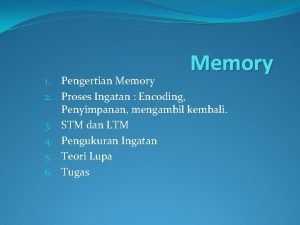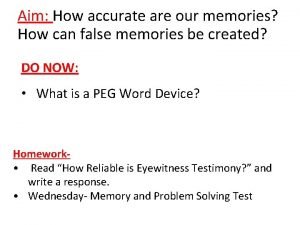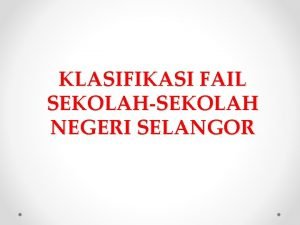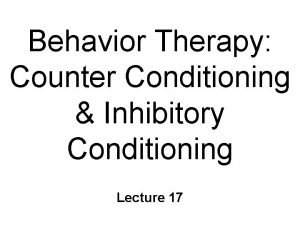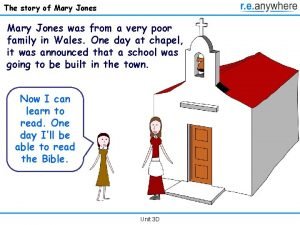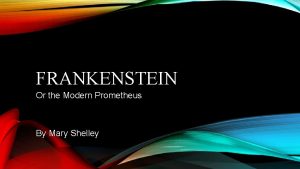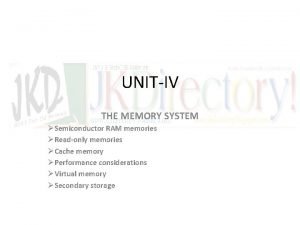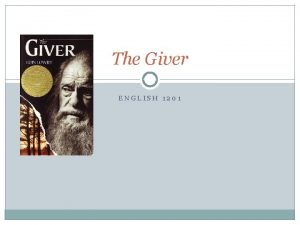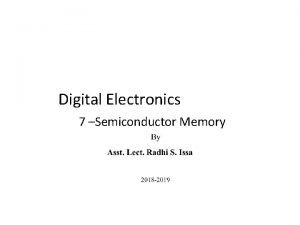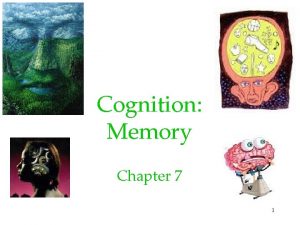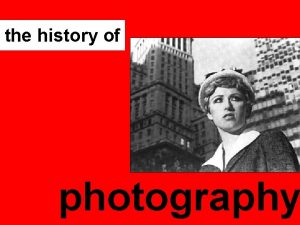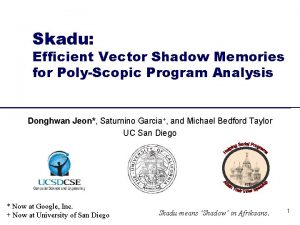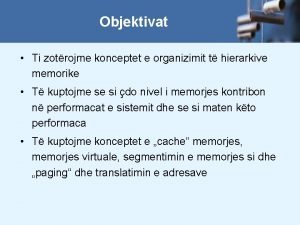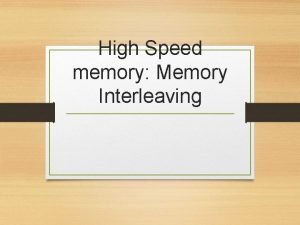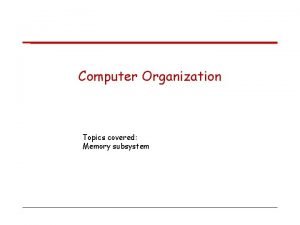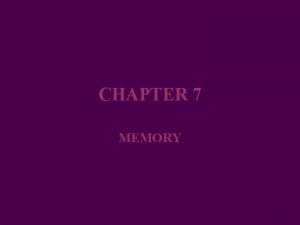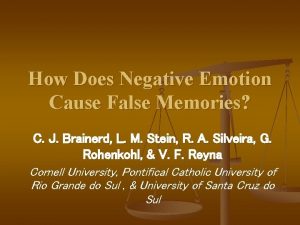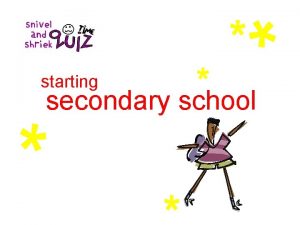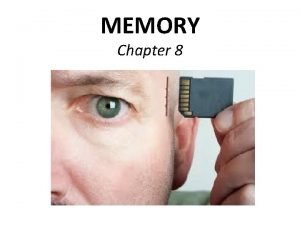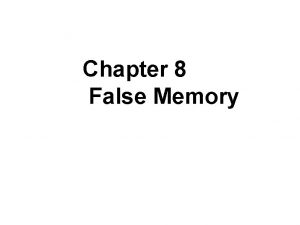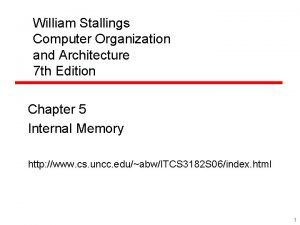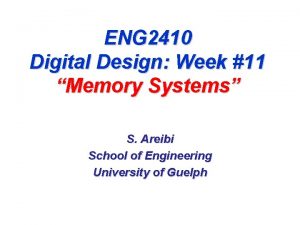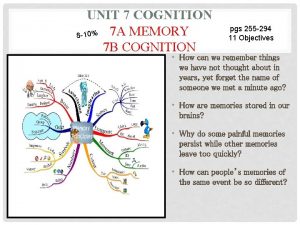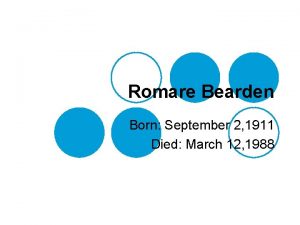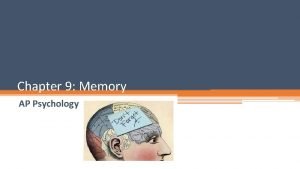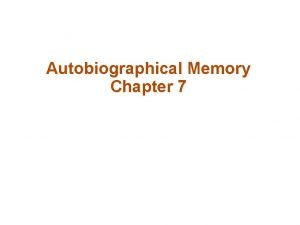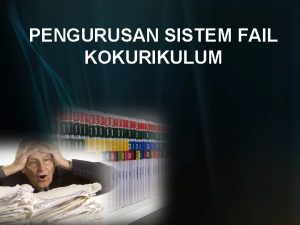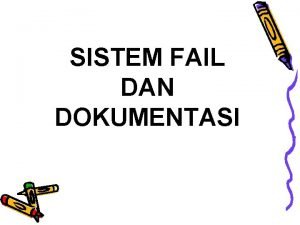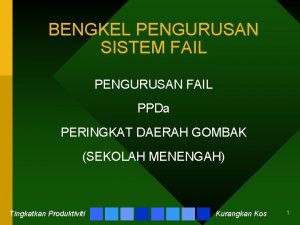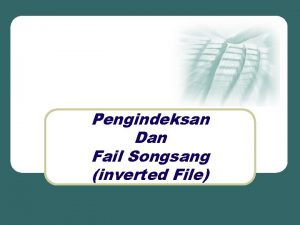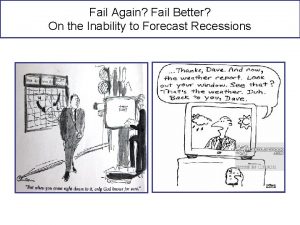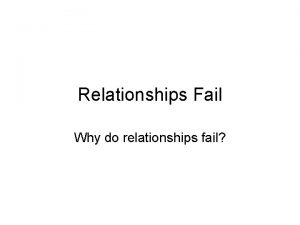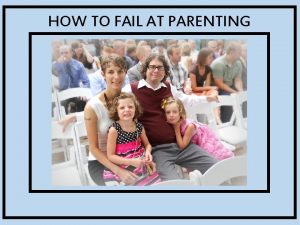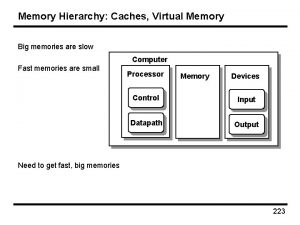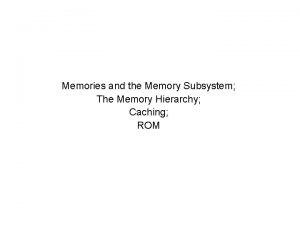Mary Jones Memory Our memories may fail us






















































- Slides: 54

Mary Jones

Memory Our memories may fail us sometimes, but they are essential for life as we currently experience it. Without memory, we would be lost in the present.

In This Chapter Three-Stage Model of Memory Encoding Information into Memory Retrieving Information from Memory

The Three-Stage Model of Memory Sensory Memory Short-Term Memory Long-Term Memory

The Three-Stage Model of Memory

The Three-Stage Model • The Three-Stage Model - Has guided research in memory since the late 1960 s Views memory as composed of three relatively distinct stages

The Three-Stage Model • Sensory memory (SM) - Consists of a set of five registers that serve as temporary storage places, one from each sense Used for incoming sensory information from the physical environment until we attend to it, interpret it, and it proceeds to the next stage of memory

The Three-Stage Model • Iconic memory - Is an exact copy of visual information Less than a second in duration Has very large capacity

Testing Iconic Memory Temporal integration procedure • Involves giving two random meaningless dot patterns sequentially at the same visual location with a brief time delay between the two presentations • Creates a meaningful pattern when the two patterns are integrated somewhere in the memory system • Time delay between the two presentations must be no longer than one second or no meaningful pattern can be perceived

An Example of the Temporal Integration Procedure What do you see?

Testing Iconic Memory Sperling’s fulland partial-report procedures • Participants presented with a different 3 x 3 matrix of unrelated consonants (a total of 9) for 50 ms across numerous experimental trials Full-report procedure Partial-report procedure • Participants had to report the entire matrix • Participants sensed the entire matrix but could not report all 9 letters • Participants had to report only one row of the matrix • An immediate auditory cue resulted in successful recall; a one second delay resulted in poorer recall

A 3 3 3 Letter Matrix • A 3 3 3 letter matrix like those used in Sperling’s iconic memory research

What does the lightning tell you?

The Three-Stage Model • Short-term memory (STM) - - Is the memory stage in which the recognized information from sensory memory enters consciousness Involves present, conscious cognitive processing Serves as a place to rehearse information Involves concentrating on information or it will be lost in 30 seconds

Capacity of Short-Term Memory • Memory span - Average number of items that can be remembered across a series of memory span trials Humans have a memory span of 7+/- 2 (5 to 9) chunks of information • Memory span task - Tests for the capacity of short-term memory by giving a series of items one at a time in a given order • Chunk - Meaningful unit of information

Duration of Short-Term Memory Distractor task • People given a small amount of information (e. g. , three unrelated consonants such as CWZ) • Immediate distraction used to deter concentration on the information for a brief time period (by counting backward aloud by 3’s) • Information recall gathered • Maintenance rehearsal used to keep information in short-term memory

Results for the Short-Term Memory Distractor Task


Short-Term Memory • Maintenance rehearsal - Type of rehearsal in short-term memory in which the information is repeated over and over again in order to maintain it

The Three-Stage Model • Long-term memory (LTM) - Allows storage of information for a long period of time (perhaps permanently) Has essentially unlimited capacity

Types of Long-Term Memory • Explicit memory (also called declarative memory) - Long-term memory for factual knowledge and personal experiences Requires conscious recall • Two types of explicit memories - Semantic memories Episodic memories

Types of Long-Term Memory

Types of Long-Term Memory • Implicit memory (also called non-declarative memory) - Long-term memory that influences behavior, but does not require conscious awareness or declarative statements • Procedural memories - Have a physical procedural aspect to them • Priming - Involves implicit influence of an earlier presented stimulus on the response to a later stimulus

Amnesia: Loss of Long-Term Memories • Amnesics - People with severe memory deficits following brain surgery or injury • Anterograde amnesia - Inability to form long-term memories for events following brain surgery or trauma • Retrograde amnesia - Inability to remember events before, especially just before, surgery or trauma

The Mirror-Tracing Task • The task is to trace the outline of a star (or some other shape) with a metal stylus when the star and your hand can be seen only in the mirror • Thus, the tracing movements have to be made in the direction opposite from the way in which they appear in the mirror

Infantile Amnesia • Cerebellum seems to be important formation of implicit memories • Hippocampus seems to be important formation of explicit memories - Hippocampus does not fully develop until about the age of 3 This explains why we cannot remember as adults events that occurred prior to this age

Evidence for the Short-Term vs. Long-Term Distinction Free recall task • Experimental procedure in which participants are given a list of words one at a time, then asked to recall them in any order they wish • Primacy effect • Recency effect After viewing the next slide, what can you conclude about each of these effects?

Evidence for the Short-Term vs. Long-Term Distinction • Recency effect is caused by recall from short-term memory • Primacy effect is the result of superior recall from long-term memory of the first few words in the list

Serial Position Effects for the Free Recall Task

Encoding Information into Memory How We Encode Information How to Improve Encoding

Memory System Processes Encoding • Process of transferring information from one memory stage to the next Retrieval Storage • Process of bringing stored information from long-term memory to the conscious level in short-term memory • Process of maintaining information in a particular stage

How We Encode Information • Effortful processing - Occurs consciously and requires attention • Automatic processing - Occurs subconsciously and does not require attention

How We Encode Information • Describes what types of encoding lead to better retrieval Levels-of. Processing Theory • Contains three levels of processing • Physical: How the information appears • Acoustic: How the information sounds • Semantic: What the information means

Differences in Recognition Memory for Words Processed at Different Levels • Participants were presented a long list of words one at a time and had to answer a question about each word as it was presented • What does the figure tell us about differences in recognition memory?

How We Encode Information • Elaborative rehearsal - - Rehearsing information by relating new information to information already in long-term memory Provides more retrieval cues to facilitate retrieval Contrasts with maintenance rehearsal (i. e. , the repetitive cycling of information in short-term memory)

How We Encode Information • Self-reference effect - Contends it is easier to remember information that you have related to yourself Suggests such connections provide more retrieval cues and lend more meaning to the new information

Environmental Effects on Encoding • Encoding specificity principle - Proposes that cues present during encoding serve as the best cues for retrieval • State-dependent memory - Depends upon the relationship of one’s physiological state at the time of encoding and at the time of retrieval

Environmental Effects on Encoding • Mood-dependent memory effects - Demonstrate that memory is better when a person’s mood is the same during encoding and retrieval • Mood-congruence effect - Demonstrates that memory is better for experiences that are congruent with a person’s current mood

How to Improve Encoding • Mnemonics - Memory aids that require elaborative rehearsal • Method of loci - Sequential pieces of information to be remembered are first associated with sequential locations in a very familiar room or location • Peg-word system - Items to be remembered that are visually associated in a memorized jingle

Other Tips for Improving Encoding • Spacing effect (or distributed study effect) - Contends that memory will improve if you study for an exam over an extended time interval rather than just a few days before the exam • Overlearning - Involves studying material past the point of initial learning Has been demonstrated to aid in retrieval of that information

Retrieving Information from Memory How to Measure Retrieval Why We Forget The Reconstructive Nature of Retrieval

How to Measure Retrieval • Recall - Measure of retrieval that requires the reproduction of the information with essentially no retrieval cues • Recognition - Measure of retrieval that only requires the identification of the information in the presence of retrieval cues • Relearning (savings method) - Measure of the amount of time saved when learning information for a second time

An Early Study • - - Conducted first experimental studies on human memory more than 100 years ago using the relearning method Mastered and relearned list of nonsense syllables Computed a savings score Concluded that the “forgetting curve” reveals that most forgetting occurs in the first two days after learning material Bettmann/Corbis Ebbinghaus Hermann Ebbinghaus

Forgetting Curve for Long-Term Memory

Why We Forget Encoding failure theory Storage decay theory • Contends sometimes forgetting is not really forgetting, but rather that the information never entered long-term memory in the first place • Suggests that forgetting occurs because of a problem in the storage of the information

An Example of Encoding Failure Can you identify the real penny? Most Americans cannot. Why?

Why We Forget Cuedependent theory Interference theory • Posits that people forget because the cues necessary for retrieval are not available • Suggests information is in memory, but inaccessible • Proposes that other similar information interferes and makes the forgotten information inaccessible

Types of Interference • Proactive interference - Occurs when information you already know makes it hard to retrieve newly learned information • Retroactive interference - Occurs when information you just learned makes it hard to retrieve old information Let’s consider an example of each kind of interference.

Types of Interference


The Reconstructive Nature of Retrieval • Retrieval re-construction - Is guided by schemas • Schemas - Are organized frameworks of knowledge about people, objects, and events that tell us what normally happens in a given situation Allow more efficient information encoding and retrieving Can lead people to “misremember” information so that it is more consistent with personal schemas

The Reconstructive Nature of Retrieval • Source misattribution - Occurs when we do not remember the true source of a memory and attribute the memory to the wrong source Results in false memories, which are inaccurate memories that feel as real as accurate memories • False memories - Can also occur because of the misinformation effect, which occurs when a memory is distorted by subsequent exposure to misleading information

A Study of False Memories Loftus and Palmer (1974) showed people a film of a traffic accident and later tested their memory for the accident • Some people were asked “How fast were the cars going when they smashed into each other? ” • Others were asked “How fast were the cars going when they hit each other? ” Can you predict the responses for each group? What contributed to your answer?

Memory and Testimony • False memories - Suggest that eyewitness testimony is subject to error and manipulated by misleading information Suggest that recovered memories are not necessarily accurate
 Contoh soal pengukuran ingatan langsung
Contoh soal pengukuran ingatan langsung How accurate are our memories
How accurate are our memories Fail am 435-pin 1/80
Fail am 435-pin 1/80 If you fail to plan, you are planning to fail
If you fail to plan, you are planning to fail People don t plan to fail they fail to plan
People don t plan to fail they fail to plan Counter conditioning therapy
Counter conditioning therapy Mary jones
Mary jones Mary cover jones experiment
Mary cover jones experiment Mary wollstonecraft mary a fiction
Mary wollstonecraft mary a fiction Our father prayer hail mary
Our father prayer hail mary Frankenstein setting time and place
Frankenstein setting time and place Episodic memory vs semantic memory
Episodic memory vs semantic memory Implicit memory
Implicit memory Long term memory vs short term memory
Long term memory vs short term memory Internal memory and external memory
Internal memory and external memory Primary memory and secondary memory
Primary memory and secondary memory Physical address vs logical address
Physical address vs logical address Which memory is the actual working memory?
Which memory is the actual working memory? Page fault
Page fault Virtual memory in memory hierarchy consists of
Virtual memory in memory hierarchy consists of Eidetic memory vs iconic memory
Eidetic memory vs iconic memory Shared vs distributed memory
Shared vs distributed memory Semiconductor ram memories
Semiconductor ram memories What method does the giver use to train jonas?
What method does the giver use to train jonas? Where are memories stored
Where are memories stored Irvine valley memories
Irvine valley memories Expanding memory size in digital electronics
Expanding memory size in digital electronics Explicit memories
Explicit memories Sorrow of rizal
Sorrow of rizal How to preserve personal memories
How to preserve personal memories Shadow memories of space
Shadow memories of space Hierarkia e memories
Hierarkia e memories Interleaved memory organization
Interleaved memory organization The picture of the soldiers………. . back many memories.
The picture of the soldiers………. . back many memories. Semiconductor ram memories in computer organization
Semiconductor ram memories in computer organization Repressed memories
Repressed memories How does negative emotion cause false memories
How does negative emotion cause false memories I like school poem by lenore hetrick
I like school poem by lenore hetrick Memories q
Memories q N the zone sports photography
N the zone sports photography Memories definition
Memories definition False memories chapter 8
False memories chapter 8 Year 6 leavers poem from teacher
Year 6 leavers poem from teacher Semiconductor ram memories in computer organization
Semiconductor ram memories in computer organization Memories (2013)
Memories (2013) Semiconductor ram memories in computer organization
Semiconductor ram memories in computer organization What effortful processing methods aid in forming memories?
What effortful processing methods aid in forming memories? When did romare bearden die
When did romare bearden die Memories factory
Memories factory Loftus experiment
Loftus experiment Light bulb memories
Light bulb memories Thinking language and intelligence
Thinking language and intelligence Our census our future
Our census our future Christ be our light shine in our hearts
Christ be our light shine in our hearts Our life is what our thoughts make it
Our life is what our thoughts make it
